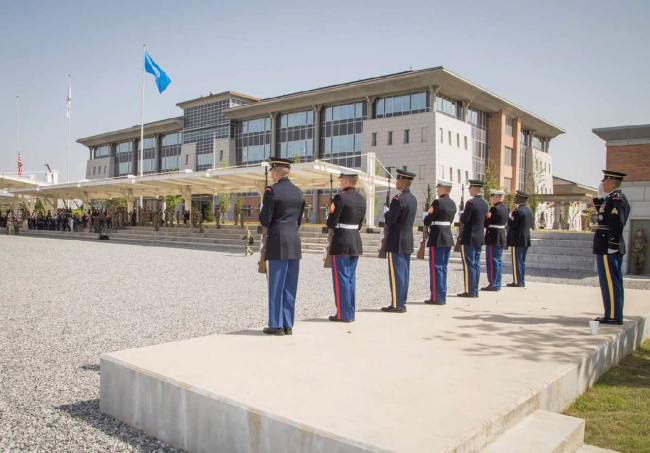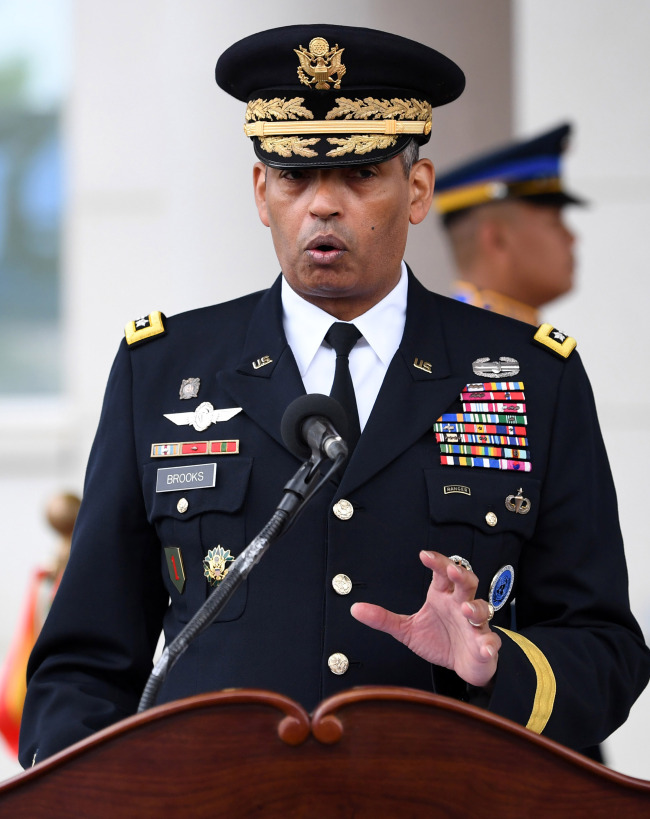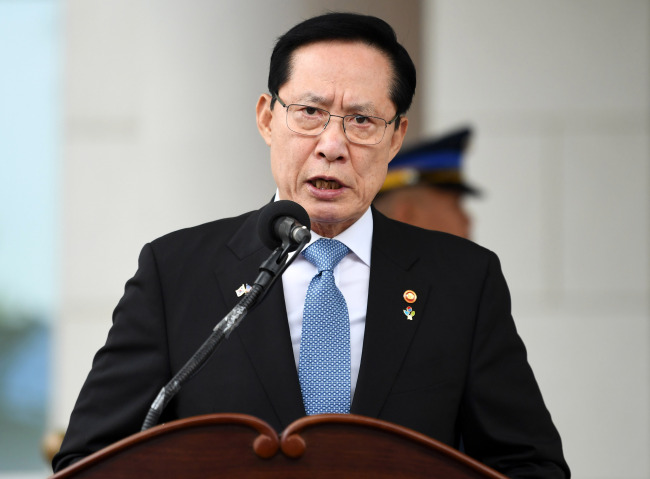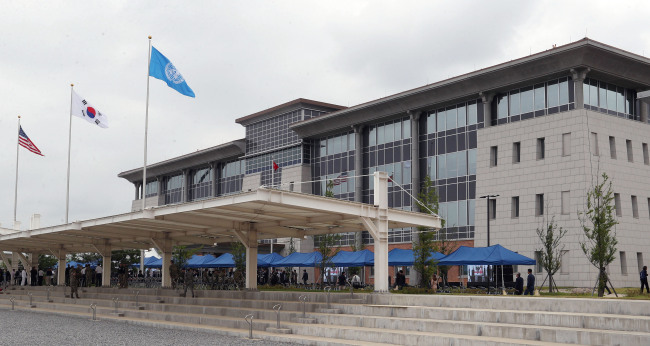PYEONGTAEK, Gyeonggi Province -- The US Forces Korea opened its new headquarters in Pyeongtaek, south of Seoul, on Friday, in a relocation project likely to broaden its security role long defined by deterrence against North Korea.
The USFK held a ceremony to celebrate the relocation from Yongsan, central Seoul, to Camp Humphreys, a sprawling complex about 70 kilometers south of the capital, after a delay caused by residents' protests, budgetary issues and massive construction work to prevent floods.
The USFK held a ceremony to celebrate the relocation from Yongsan, central Seoul, to Camp Humphreys, a sprawling complex about 70 kilometers south of the capital, after a delay caused by residents' protests, budgetary issues and massive construction work to prevent floods.

"Today marks a historic milestone in the history of the United Nations Command which began in 1950 and the history of the ROK (South Korea)-US alliance," USFK commander Gen. Vincent Brooks said at the ceremony that marked the end of the era for Yongsan as both USFK and UNC headquarters.
"Indeed today, the UNC continues to be the home for the international commitment with the mandate to restore peace and security in the defense of the Republic of Korea. USFK will remain the living proof of the American commitment to the alliance," he added.
The UNC oversees the armistice that halted the 1950-53 Korean War, while the USFK, along with the South Korea-US Combined Forces Command, is a force provider in case of contingencies as well as a deterrent against Pyongyang's possible aggression.
Brooks leads the UNC, USFK and CFC.
Brooks also pointed out South Korea's financial contribution to the relocation project.

"This headquarters building within the complex represents a significant investment in the long-term presence of the US forces in Korea. Ladies and gentlemen, this was a project that cost nearly $10.8 billion to build over 10 years," he said.
"The Republic of Korea's investment was over 90 percent of the cost, and for that 90 percent, the United States remains with you 100 percent," he added.
The relocation marked the separation of the USFK and UNC headquarters from that of the CFC still in Seoul.
"For the first time, the ROK-US CFC, an outgrowth of the UNC, will be geographically separated from the headquarters of the UNC and from the headquarters of the USFK," he said.
"Our relationships and our history are intertwined and they are strong enough to support this separation without weakening any of the three commands," he added.
South Korean President Moon Jae-in said that the new headquarters will help ensure the stable stationing of the USFK.
"Through the opening of the (new) era in Pyeongtaek, I hope that the South Korea-US alliance will evolve into a great alliance beyond the military, comprehensive alliance," he said in a speech read out by his security aide Lee Sang-chul.
"The alliance has been the foundation for peace and stability and paved the way for South Korea's democratization and economic growth," he added.
South Korea's Defense Minister Song Young-moo said that the USFK will embrace a new role in the new military complex.

"The new (USFK) mission will be an important one to contribute not only to peace on the peninsula but also to world peace as a stabilizer in Northeast Asia," he said.
The new USFK headquarters, spanning 240,000 square meters, consists of a four-story main building with a two-story annex.
The 8th Army, a ground USFK component, already relocated its headquarters to Pyeongtaek in July, while service members of the USFK and the UNC are set to move to Pyeongtaek by the end of the year.
The South Korea-US Combined Forces Command is to move to a separate seven-story building inside Seoul's Ministry of National Defense by year's end.
Friday's ceremony comes amid brisk diplomacy aimed at the North's denuclearization and the establishment of a peace regime, which analysts said could lead to a reduction -- or pullout -- of the USFK or a shift in its role and modus operandi.
Nam Chang-hee, security expert at Inha University, said that the relocation raises the prospect of the USFK undertaking a broad role as a regional security purveyor.
"The US 2nd Infantry Division, situated in the North's infiltration route, had served as a tripwire (for defense against the North), but as it moves to a rear area further south, its role could be readjusted to undertake a security mission beyond the peninsula," he said.
"After all, the South and the US apparently affirmed through action that their alliance not only targets the North, but also seeks to play a central role on the peninsula, in Northeast Asia and the world," he added.
The allies agreed to the relocation program in May 2003. The agreement came as Washington was seeking for greater strategic flexibility in its USFK operations, in line with its military realignment program, called the Global Defense Posture Review.
The $10.8 billion program, funded by Seoul, seeks to consolidate US bases across the peninsula into two garrisons in Pyeongtaek and Daegu. It is comprised of the Yongsan Relocation Plan and the Land Partnership Plan, which call for moving the USFK and UNC headquarters in Seoul, and troops north of the capital to Pyeongtaek, respectively.
The USFK established its Yongsan headquarters in July 1957 after the end of the 1950-53 Korean War.

A large group of US troops first entered the peninsula in September 1945, less than a month after Korea was liberated from Japan's 36-year colonial rule. Their mission was to disarm Japanese troops south of the 38th parallel, a line drawn by the United States and the then-Soviet Union.
At the time, Washington sent to Korea its 24th Army Corps consisting of the 6th, 7th and 40th Divisions that took charge of the southwestern region, Seoul and the surrounding areas, and the southeastern region, respectively, as part of the then-US military administration. In November 1945, the number of American troops in Korea topped 70,000.
As part of its post-war military realignment, Washington began curtailing its troops in East Asia, then a region of less strategic significance than Europe. In June 1949, it withdrew all troops in Korea except for some 500 of the US Military Advisory Group.
Subsequently, the 24th Corps was dissolved, while the 6th and 8th Armies in Japan were disassembled and scaled back, respectively. As a result, only the 8th Army, 5th Air Force and 7th Fleet -- all under the US Far East Command -- were left in East Asia.
Following the North's invasion on June 25, 1950, American troops returned to the peninsula to defend the South under a UN mandate. During the Korean War, the US dispatched more than 320,000 troops to the South.
Currently, the USFK maintains some 28,500 troops. But the troop level can drop below that number or swell to over 30,000 due to the presence of rotational units or training exercises. (Yonhap)







![[Graphic News] More Koreans say they plan long-distance trips this year](http://res.heraldm.com/phpwas/restmb_idxmake.php?idx=644&simg=/content/image/2024/04/17/20240417050828_0.gif&u=)
![[KH Explains] Hyundai's full hybrid edge to pay off amid slow transition to pure EVs](http://res.heraldm.com/phpwas/restmb_idxmake.php?idx=644&simg=/content/image/2024/04/18/20240418050645_0.jpg&u=20240419100350)






![[From the Scene] Monks, Buddhists hail return of remains of Buddhas](http://res.heraldm.com/phpwas/restmb_idxmake.php?idx=652&simg=/content/image/2024/04/19/20240419050617_0.jpg&u=20240419175937)

![[KH Explains] Hyundai's full hybrid edge to pay off amid slow transition to pure EVs](http://res.heraldm.com/phpwas/restmb_idxmake.php?idx=652&simg=/content/image/2024/04/18/20240418050645_0.jpg&u=20240419100350)

![[Today’s K-pop] Illit drops debut single remix](http://res.heraldm.com/phpwas/restmb_idxmake.php?idx=642&simg=/content/image/2024/04/19/20240419050612_0.jpg&u=)